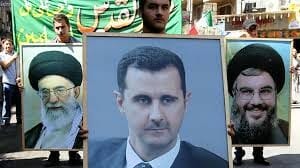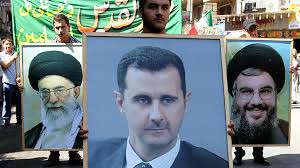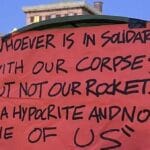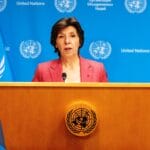Von Thomas von der Osten-Sacken
 Die libanesische Journalistin Hanin Ghaddar erklärt, worum es dem Iran in Syrien und anderen Ländern der Region geht: Um die Einrichtung eines von ihm kontrollierten „schiitischen Halbmondes“, der bis an die Grenzen Israels reicht und den Irak, Syrien und den Libanon umfasst. Damaskus und Zentralsyrien stellen das Herzstück dieser Region dar, verbinden sie doch den Irak mit dem Libanon: Die Vertreibung seiner sunnitischen Bewohner folgt dieser Strategie und hat System, weshalb die Evakuierung Darajas und anderer Vororte der syrischen Hauptstadt so wichtig für Assad wie auch für den Iran sind:
Die libanesische Journalistin Hanin Ghaddar erklärt, worum es dem Iran in Syrien und anderen Ländern der Region geht: Um die Einrichtung eines von ihm kontrollierten „schiitischen Halbmondes“, der bis an die Grenzen Israels reicht und den Irak, Syrien und den Libanon umfasst. Damaskus und Zentralsyrien stellen das Herzstück dieser Region dar, verbinden sie doch den Irak mit dem Libanon: Die Vertreibung seiner sunnitischen Bewohner folgt dieser Strategie und hat System, weshalb die Evakuierung Darajas und anderer Vororte der syrischen Hauptstadt so wichtig für Assad wie auch für den Iran sind:
„While Assad’s demography strategy is aimed at helping the regime maintain control over Damascus, Iran and its proxy militias are also very invested in the process. Tehran hopes that the deals with besieged Sunni towns will further its own ‚useful Syria‘ strategy, which entails wresting control over a corridor linking Syria’s coastal region with Hezbollah’s strongholds in Lebanon. As Iran’s main Shiite proxy force, Hezbollah has already conducted ethnic cleansing of its own in certain areas along the border (e.g., its 2013 campaigns in al-Qusayr and the Qalamoun region). Also, hundreds of thousands of Sunnis were evacuated from Homs between 2011 and 2014, when a deal was finally struck with regime forces after starvation reached horrifying levels.
As a result of these efforts, the corridor linking Qalamoun to Damascus, Homs, and the Alawite enclave may soon be Sunni-free. In addition to shielding the capital from the mainly Sunni anti-Assad forces, this development would give Hezbollah safe access to the Golan Heights, potentially allowing the group to open another front against Israel.“
Diese Strategie wird weiter auf erbitterten Widerstand stoßen und für eine weitere Eskalation konfessionalisierter Gewalt sorgen. Ohne dauerhafte Präsenz hunderttausender iranisch finanzierter und kontrollierter Milizen und Soldaten wird sie nicht funktionieren. Und so sind alle diplomatischen Vorstöße, die im Iran irgendwie einen Friedenspartner oder „Stabilitätsanker“ sehen, auch weiter zum Scheitern verurteilt – statt Frieden droht der Syrienkrieg, dann die ganze Region in den Abgrund zu reißen:
„Thus, any solution that does not recognize the dangers of Iranian regional hegemony will not work, especially if Assad stays in power. The majority of the region’s inhabitants are Sunnis, and they will not welcome the prospect of a murderous Alawite regime retaining control in Syria, nor an Iranian Shiite crescent that envelops several countries. Under such circumstances, sectarian rifts would only widen, and more Sunnis might turn to extremist groups that promise bloodier solutions. The Islamic State and al-Qaeda affiliate Jabhat al-Nusra would likely live on in some form or another, cultivating perpetual terrorist threats within these Iranian-dominated states.
A political solution for Syria – whether presented jointly by the United States and Russia, or by UN envoy Staffan de Mistura, who said on September 1 that he plans to present a ‚quite clear political initiative‘ – should be comprehensive and fair. It also should take into consideration the regional context, mainly in Iraq and Lebanon. Otherwise, Syria’s sectarian civil war could eat up the entire region.“
Was aber, wenn all dies in Washington ohnehin bekannt ist? Wenn Syrien der Preis ist, den man für einen Deal mit dem Iran bereit war zu zahlen, ja wenn Syrien sogar Teil des Irandeals war? Dann sind alle Appelle an eine „comphrehensive and fair solution“ bestenfalls Ausdruck von Wunschdenken. Lee Smith etwa geht davon aus, die Obama Administration – und mit ihr natürlich auch alle europäischen Unterstützer eines Deals mit dem Iran –, stimmten damals auch zu, dass Syrien (und der Irak, aus dem man 2011 abgezogen war, um ihn Teheran zu überlassen) zur künftigen iranischen Einflusssphäre gehören werden; dass also Teheran ungestört seinen „schiitischen Halbmond“, vor dem Ghaddar warnt, errichten könne:
„In short, the Iran deal wasn’t just about limits on uranium enrichment, inspections of nuclear facilities, and sanctions relief, etc., it was also about the Syrian conflict – in particular, about the United States agreeing to step back and let Iran protect its ‚equities‘ in Syria, by whatever means its gruesome proxy saw fit.“
Wer den Iran-Deal damals befürwortete, der so Smith weiter, der sollte sich nicht über die Folgen in Syrien empören. Schließlich fließe auch das Geld, über das Teheran aufgrund des Atomabkommens nun verfüge, direkt in seine Kriegskassen:
„The reason that so many journalists and opinion-makers of good conscience cannot make the connection between the Iran deal and the Syrian war is because the truth is too awful. The president’s policy is not simply a matter of a lack of vision or political will. The money Iran received through the JCPOA, as well as the $1.7 billion paid in ransom for American hostages, has helped fund Iran’s war in Syria – which the president proclaimed to be Iran’s business and not ours.
I have no doubt that the people tweeting pictures of Omran Daqneesh and all the other children who have died in Syria and will continue to die there are sincere in their horror at the suffering of innocents, just as they were sincere in their belief that the JCPOA was the best available hedge against a future war or the specter of an Iranian bomb. In Obama’s defense, he at least understood the price of an agreement. Sadly, his supporters-turned-critics didn’t – and they still don’t.“






